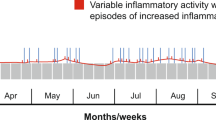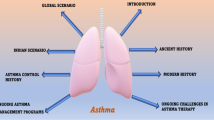Abstract
The goals of asthma management are accurate diagnosis, prompt initiation of treatment and monitoring of disease progression to limit potential morbidity and mortality. While the diagnosis and management is largely based on history taking and clinical examination, there are an increasing number of tools available that could be used to aid diagnosis, define phenotypes, monitor progress and assess response to treatment. Tools such as the Asthma Predictive Index could help in making predictions about the possibility of asthma in childhood based on certain clinical parameters in pre-schoolers. Lung function measurements such as peak expiratory flow, spirometry, bronchodilator responsiveness, and bronchial provocation tests help establish airway obstruction and variability over time. Tools such as asthma questionnaires, lung function measurements and markers of airway inflammation could be used in combination with clinical assessments to assess ongoing asthma control. Recent advances in digital technology, which open up new frontiers in asthma management, need to be evaluated and embraced if proven to be of value. This review summarises the role of currently available tools in asthma diagnosis and management. While many of the tools are readily available in resource rich settings, it becomes more challenging when working in resource poor settings. A rational approach to the use of these tools is recommended.

Similar content being viewed by others
References
Morgan WJ, Stern DA, Sherrill DL, et al. Outcome of asthma and wheezing in the first 6 years of life: follow-up through adolescence. Am J Respir Crit Care Med. 2005;172:1253–8.
Tai A, Tran H, Roberts M, et al. Outcomes of childhood asthma to the age of 50 years. J Allergy Clin Immunol. 2014;133:1572–8.e3.
Torjesen I. Two thirds of deaths from asthma are preventable, confidential inquiry finds. BMJ. 2014;348:g3108.
Bisgaard H, Szefler S. Prevalence of asthma-like symptoms in young children. Pediatr Pulmonol. 2007;42:723–8.
Castro-Rodriguez JA, Holberg CJ, Wright AL, Martinez FD. A clinical index to define risk of asthma in young children with recurrent wheezing. Am J Respir Crit Care Med. 2000;162:1403–6.
Global Initiative for Asthma. Global Strategies for Asthma Management and Prevention, 2017. Available at: www.ginasthma.org. Accessed on 10th April 2017.
Pellegrino R, Viegi G, Brusasco V, et al. Interpretative strategies for lung function tests. Eur Respir J. 2005;26:948–68.
Beydon N, Davis SD, Lombardi E, et al. An official American Thoracic Society/European Respiratory Society statement: pulmonary function testing in preschool children. Am J Respir Crit Care Med. 2007;175:1304–5.
Quanjer PH, Stanojevic S, Cole TJ, et al. Multi-ethnic reference values for spirometry for the 3-95-yr age range: the global lung function 2012 equations. Eur Respir J. 2012;40:1324–43.
Raywood E, Lum S, Aurora P, Pike K. The bronchodilator response in preschool children: a systematic review. Pediatr Pulmonol. 2016;51:1242–50.
James DR, Lyttle MD. British guideline on the management of asthma: SIGN clinical guideline 141, 2014. Arch Dis Child Educ Pract Ed. 2016;101:319–22.
Borrego LM, Stocks J, Almeida I, et al. Bronchodilator responsiveness using spirometry in healthy and asthmatic preschool children. Arch Dis Child. 2013;98:112–7.
Busi LE, Restuccia S, Tourres R, Sly PD. Assessing bronchodilator response in preschool children using spirometry. Thorax. 2017;72:367–72.
Joseph-Bowen J, de Klerk NH, Firth MJ, Kendall GE, Holt PG, Sly PD. Lung function, bronchial responsiveness, and asthma in a community cohort of 6-year-old children. Am J Respir Crit Care Med. 2004;169:850–4.
Carlsen KH, Engh G, Mork M, Schroder E. Cold air inhalation and exercise-induced bronchoconstriction in relationship to metacholine bronchial responsiveness: different patterns in asthmatic children and children with other chronic lung diseases. Respir Med. 1998;92:308–15.
Riedler J, Reade T, Dalton M, Holst D, Robertson C. Hypertonic saline challenge in an epidemiologic survey of asthma in children. Am J Respir Crit Care Med. 1994;150:1632–9.
Verini M, Peroni DG, Rossi N, et al. Functional assessment of allergic asthmatic children while asymptomatic. Allergy Asthma Proc. 2006;27:359–64.
Mahut B, Trinquart L, Bokov P, et al. Relationships between specific airway resistance and forced expiratory flows in asthmatic children. PLoS One. 2009;4:e5270.
Kooi EM, Schokker S, van der Molen T, Duiverman EJ. Airway resistance measurements in pre-school children with asthmatic symptoms: the interrupter technique. Respir Med. 2006;100:955–64.
Shi Y, Aledia AS, Galant SP, George SC. Peripheral airway impairment measured by oscillometry predicts loss of asthma control in children. J Allergy Clin Immunol. 2013;131:718–23.
Skylogianni E, Douros K, Anthracopoulos MB, Fouzas S. The forced oscillation technique in paediatric respiratory practice. Paediatr Respir Rev. 2016;18:46–51.
van der Heijden HH, Brouwer ML, Hoekstra F, van der Pol P, Merkus PJ. Reference values of exhaled nitric oxide in healthy children 1-5 years using off-line tidal breathing. Pediatr Pulmonol. 2014;49:291–5.
National Institute for Health and Care Excellence (NICE). Asthma: diagnosis and monitoring of asthma in adults, children and young people (draft for consultation). London: NICE; 2015.
Dweik RA, Boggs PB, Erzurum SC, et al. An official ATS clinical practice guideline: interpretation of exhaled nitric oxide levels (FeNO) for clinical applications. Am J Respir Crit Care Med. 2011;184:602–15.
Sachs-Olsen C, Lodrup Carlsen KC, Mowinckel P, et al. Diagnostic value of exhaled nitric oxide in childhood asthma and allergy. Pediatr Allergy Immunol. 2010;21:e213–21.
Singer F, Luchsinger I, Inci D, et al. Exhaled nitric oxide in symptomatic children at preschool age predicts later asthma. Allergy. 2013;68:531–8.
Carroll WD, Lenney W, Child F, et al. Asthma severity and atopy: how clear is the relationship? Arch Dis Child. 2006;91:405–9.
Sly PD, Boner AL, Bjorksten B, et al. Early identification of atopy in the prediction of persistent asthma in children. Lancet. 2008;372:1100–6.
Juniper EF, Gruffydd-Jones K, Ward S, Svensson K. Asthma control questionnaire in children: validation, measurement properties, interpretation. Eur Respir J. 2010;36:1410–6.
Jia CE, Zhang HP, Lv Y, et al. The asthma control test and asthma control questionnaire for assessing asthma control: systematic review and meta-analysis. J Allergy Clin Immunol. 2013;131:695–703.
Voorend-van Bergen S, Vaessen-Verberne AA, de Jongste JC, Pijnenburg MW. Asthma control questionnaires in the management of asthma in children: a review. Pediatr Pulmonol. 2015;50:202–8.
Pijnenburg MW, Baraldi E, Brand PL, et al. Monitoring asthma in children. Eur Respir J. 2015;45:906–25.
Baker RR, Mishoe SC, Zaitoun FH, Arant CB, Lucas J, Rupp NT. Poor perception of airway obstruction in children with asthma. J Asthma. 2000;37:613–24.
Fuhlbrigge AL, Kitch BT, Paltiel AD, et al. FEV(1) is associated with risk of asthma attacks in a pediatric population. J Allergy Clin Immunol. 2001;107:61–7.
Nuijsink M, Hop WC, Sterk PJ, Duiverman EJ, de Jongste JC. Long-term asthma treatment guided by airway hyperresponsiveness in children: a randomised controlled trial. Eur Respir J. 2007;30:457–66.
Kamps AW, Roorda RJ, Brand PL. Peak flow diaries in childhood asthma are unreliable. Thorax. 2001;56:180–2.
Reddel HK, Marks GB, Jenkins CR. When can personal best peak flow be determined for asthma action plans? Thorax. 2004;59:922–4.
Meena RK, Raj D, Lodha R, Kabra SK. Fractional exhaled nitric oxide for identification of uncontrolled asthma in children. Indian Pediatr. 2016;53:307–10.
Petsky HL, Kew KM, Chang AB. Exhaled nitric oxide levels to guide treatment for children with asthma. Cochrane Database Syst Rev. 2016;11:CD011439.
Gibson PG, Grootendor DC, Henry RL, et al. Sputum induction in children. Eur Respir J Suppl. 2002;37:44s–6s.
Zacharasiewicz A, Wilson N, Lex C, et al. Clinical use of noninvasive measurements of airway inflammation in steroid reduction in children. Am J Respir Crit Care Med. 2005;171:1077–82.
Fleming L, Wilson N, Regamey N, Bush A. Use of sputum eosinophil counts to guide management in children with severe asthma. Thorax. 2012;67:193–8.
Lex C, Jenkins G, Wilson NM, et al. Does sputum eosinophilia predict the response to systemic corticosteroids in children with difficult asthma? Pediatr Pulmonol. 2007;42:298–303.
Thomas PS, Lowe AJ, Samarasinghe P, et al. Exhaled breath condensate in pediatric asthma: promising new advance or pouring cold water on a lot of hot air? A systematic review. Pediatr Pulmonol. 2013;48:419–42.
Morton RW, Elphick HE, Rigby AS, et al. STAAR: a randomised controlled trial of electronic adherence monitoring with reminder alarms and feedback to improve clinical outcomes for children with asthma. Thorax. 2017;72:347–54.
Huckvale K, Car M, Morrison C, Car J. Apps for asthma self-management: a systematic assessment of content and tools. BMC Med. 2012;10:144.
Author information
Authors and Affiliations
Contributions
AM and AA: Did a review of literature, wrote part of the manuscript and reviewed the manuscript; NP: Conceptualised the manuscript, wrote part of the manuscript, reviewed, approved the final draft of the manuscript and will act as guarantor for the paper. Anna Mulholland is a clinical and research fellow funded by The Starship Foundation.
Corresponding author
Ethics declarations
Conflict of Interest
None.
Source of Funding
None.
Rights and permissions
About this article
Cite this article
Mulholland, A., Ainsworth, A. & Pillarisetti, N. Tools in Asthma Evaluation and Management: When and How to Use Them?. Indian J Pediatr 85, 651–657 (2018). https://doi.org/10.1007/s12098-017-2462-6
Received:
Accepted:
Published:
Issue Date:
DOI: https://doi.org/10.1007/s12098-017-2462-6




